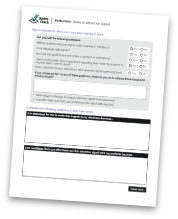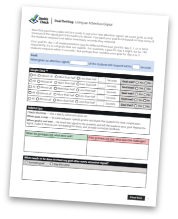Strategy: Using an Attention Signal
Check-Up Menu > Using an Attention Signal
4) Choose a signal that does not require specific conditions (e.g. flipping a light switch which would require you to stand near the switch in order to use the signal). Having flexibility to use the signal wherever you are (e.g., hallway) makes it more useful.
How To
How to Select and Implement an Attention Signal
Examples:
- Rhythmic clapping with a song
- Teacher: sing “Old McDonald Had a Farm” and clap on the words.
- Students: sing “E-I-E-I-O“ and clap on the words
- A catchy phrase
- Teacher: count on hand and say “1, 2, 3 eyes on me“ and point to eyes
- Students: count on hand and say “1, 2 eyes on you“ and point to teacher
- Counting
- Teacher: “give me five” and raise hand
- Students: count to five on fingers, raise their hands and look at the teacher




Video Prompts:
- This video shows a teacher using hand claps to gain the attention of the students before a transition.
- Notice how the students clap back to show they know it is time to transition.
- After gaining the attention of the students the teacher gives very specific directions so the students can transition smoothly.
- What did you like about this attention signal?
- How does using a signal like this help students transition to the next task smoothly?
- How might you incorporate this or other attention signals into your daily teaching?
Video Prompts:
- The students in this video are very excited about the activity. The teacher uses an attention signal that uses both her voice and a hand signal. Notice how quickly the students respond.
- Notice that the teacher provides behavior-specific praise to the students who respond (see Using Behavior-specific Praise)
- Her use of praise following a student responding helps to get other students on task and makes it more likely that students will respond quickly in the future.
- What did you like about how this teacher used this attention signal?
- How could you use a similar attention signal to help with transitions or giving instruction to your students?
Strategy Tool

Reflection

Goal Setting

References to Other Relevant Resources:
Reinke, W., Herman, K., & Sprick, R. (2011). Motivational interviewing for effective classroom management: The classroom check-up. New York, NY: Guilford Press.
Sprick, R. (2009). CHAMPS: A proactive and positive approach to classroom management. Eugene, OR: Pacific Northwest Publishing.